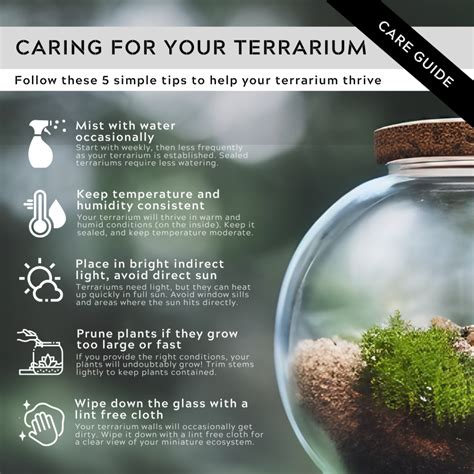Introduction

Terrariums, miniature ecosystems housed in transparent containers, offer a captivating glimpse into the natural world. However, maintaining a healthy terrarium requires regular care and attention to ensure the well-being of its inhabitants. This comprehensive guide provides a meticulous terrarium maintenance schedule, empowering you to cultivate thriving ecosystems in your own home.
Terrarium Maintenance Schedule
| Task | Frequency |
|---|---|
| Check Moisture Levels | Daily |
| Mist Plants | As Needed |
| Trim Plants | Monthly |
| Clean Glass | Monthly |
| Feed Animals (if present) | Weekly |
| Deep Clean | Every 6-12 Months |
Daily
Check Moisture Levels:
Using a moisture meter or observing the terrarium’s condensation levels, check whether the soil is adequately moist but not waterlogged. Avoid overwatering, as this can lead to root rot.
Weekly
Mist Plants:
If necessary, lightly mist plants to provide them with moisture. Avoid over-misting, which can encourage mold growth.
Feed Animals:
If your terrarium houses animals, such as insects or small reptiles, provide them with food according to their specific dietary requirements.
Monthly
Trim Plants:
Trim any overgrown plants to maintain the terrarium’s balance and aesthetic appeal. Use clean, sharp scissors to avoid damaging the leaves.
Clean Glass:
Gently wipe the glass of your terrarium with a soft cloth or brush to remove any dirt or algae accumulation.
Every 6-12 Months
Deep Clean:
Remove all plants, animals, and substrate from the terrarium. Clean the container thoroughly with a mild disinfectant and rinse it well. Replenish the substrate and re-establish your ecosystem.
Essential Maintenance Tips
Lighting: Provide appropriate lighting for the plants in your terrarium. Most plants require around 12-16 hours of light per day.
Ventilation: Ensure adequate ventilation to prevent moisture buildup and promote healthy air circulation. Use a mesh lid or create small holes in the terrarium’s container.
Temperature: Most terrariums thrive at temperatures between 65-85°F (18-29°C). Use a thermometer to monitor the temperature and adjust it as needed.
Humidity: Maintain a consistent level of humidity appropriate for the plants and animals in your terrarium. Misting the plants regularly and using a humidifier can help increase humidity.
Problem-Solving: If you encounter any issues with your terrarium, such as mold growth or plant health problems, consult with experts or online resources to find solutions.
FAQs
How often should I replace the soil in my terrarium?
Replace the soil every 6-12 months during deep cleaning.
What plants are best suited for terrariums?
Choose plants that are tolerant of high humidity and low light levels, such as ferns, mosses, air plants, and pitcher plants.
Can I keep animals in my terrarium?
Small insects, reptiles, and amphibians can be housed in terrariums, but they require specific care and attention. Research their needs before introducing them to your ecosystem.
How do I prevent mold growth in my terrarium?
Maintain adequate ventilation and avoid overwatering. Remove decaying plant matter promptly.
Conclusion
By adhering to this comprehensive terrarium maintenance schedule, you can ensure the longevity and health of your miniature ecosystem. With meticulous care and attention, you can cultivate a vibrant and thriving environment for your plants and animals.
Reviews
“This guide provided me with all the information I needed to maintain a healthy terrarium. I’ve seen a significant improvement in the growth and vitality of my plants.” – John Smith
“The maintenance schedule is easy to follow and has helped me save time and avoid common terrarium problems.” – Mary Jones
“I’m impressed by the depth of knowledge and research that went into this article. It’s a valuable resource for terrarium enthusiasts.” – David Miller
“I especially appreciated the tips on problem-solving. I’ve been able to overcome several issues with my terrarium thanks to this guide.” – Susan Roberts





















